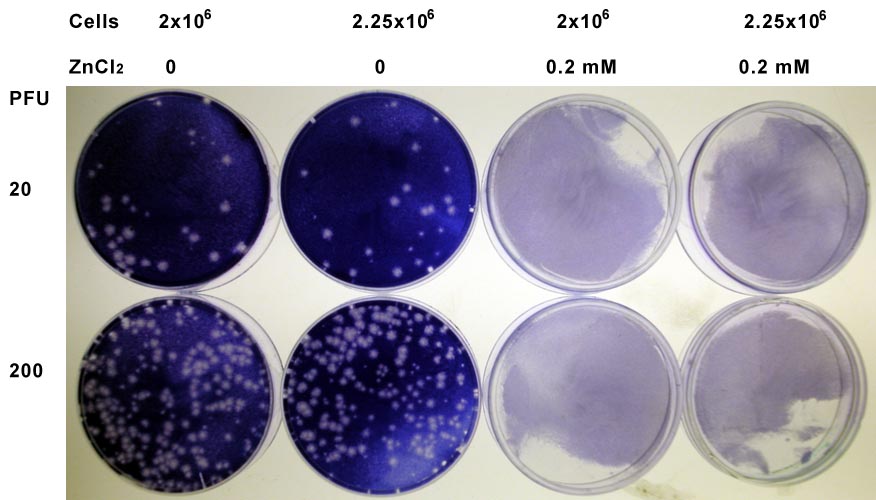So far in my experiments to understand inhibition of rhinovirus replication by ZnCl2 I’ve found that at a concentration of 0.1 mM, viral plaque formation is inhibited but not sufficiently to be able to select resistant mutants. Attempts to use higher concentrations of the metal have consistently failed.
When I initially I tried higher concentrations of ZnCl2 in the plaque assay (0.2, 0.3, 0.4 mM) the cell monolayers looked poor. I thought one reason for this apparent toxicity was that the HeLa cell monolayers were too sparse. Last week I repeated the experiment using plates of HeLa cells seeded with 2 or 2.25 million cells each the night before. I infected the cells with two different amounts of rhinovirus type 1a, added a semisolid overlay with or without ZnCl2, and incubated for four days. The results are shown below.


It’s clear that seeding the plates with 2 or 2.25 million HeLa cells made no difference: 0.2 mM ZnCl2 is still toxic to the monolayers. I find it surprising that the cells have no problem with 0.1 mM ZnCl2 but fare poorly at twice the concentration; but that is the observation and I’ll have to work around it.
Tomorrow’s experiment: try intermediate concentrations of ZnCl2 in the plaque assay, between 0.1 and 0.2 mM. It might be possible to identify a concentration that does not harm the cells but inhibits viral plaque formation >99%.

can there be a sudden jump at some specific concentration ?
Hard to believe. Are there any examples for such jumps ?
That seems to suggest some phase transition or such,
th ZnCl2 forms cristals
52 comments 0 likes 2 points
Seems consistent with the rare side effect of the nasal spray of killing nerves. Seems doubtful that it would be possible to make the concentration on nasal surfaces delivered by a spray idiot proof.
Seems consistent with the rare side effect of the nasal spray of killing nerves. Seems doubtful that it would be possible to make the concentration on nasal surfaces delivered by a spray idiot proof.
Pingback: Rhinovirus and zinc part 4: cell toxicity